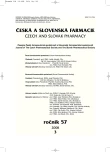Studies on local anesthetics Part 183: Micellization and thermodynamic parameters of heptacainium chloride in the solution of potassium bromide
Authors:
F. Andriamainty; J. Čižmárik; I. Malík; S. Horvat
Authors‘ workplace:
Univerzita Komenského Bratislava, Farmaceutická fakulta, Katedra farmaceutickej chémie
Published in:
Čes. slov. Farm., 2008; 57, 119-125
Category:
Original Articles
Overview
The critical micellar concentration (CMC) of the local anaesthetic agent heptacainium chloride in the solution of KBr was determined by the spectrophotometric method in the UV region of the spectrum at the temperature range of t = 20–40 °C and pH ≈ 4.5–5.0. The dependence of CMC on the temperature T turned out forming the U-shape with the minimum at the temperature of t = 25 °C. The parabolic dependence of CMC on the temperature T was drawn by the fitting of the values using the polynomial function and the so-called power law equation. The CMC dependence on the temperature T was fitted by the second degree polynomial function. The obtained parabolic equations were applied to the “phase separation model”, so the following thermodynamic parameters could be calculated: standard Gibbs free energy (∆G°), enthalpy (∆H°), and entropy (∆S°). The thermodynamic parameters were further used to determine the so-called entropy-enthalpy compensation of the systems under study. The compensation temperature was in the following range: (30 ± 1–303 ± 3)K. Then the temperature dependence of the enthalpy (∆H°) and entropy (–T∆S°) contributions to the standard Gibbs free energy (∆G°) for all prepared concentrations of the compound were calculated.
Key words:
heptacainium chloride – critical micellar concentration (CMC) – thermodynamics – standard Gibbs free energy – enthalpy – entropy.
Sources
1. Fromherz, K.: Arch. Exp. Pathol. Pharmacol., 1914; 76, 257Đ302.
2. Švec, P., Béderová, B., Račanský, P. et al.: Farm. Obzor, 1978; 47, 543Đ554.
3. Čižmárik, J., Borovanský, A., Švec, P.: Acta Facult. Pharm. Univ. Comenianae, 1976; 29, 53Đ76.
4. Andriamainty, F., Čižmárik, J.: Farm. Obzor, 2004; 73, 100-102.
5. Andriamainty, F., Čižmárik, J., Holíková, M.: Sci. Pharm., 2004; 72, 221-225.
6. Andriamainty, F., Čižmárik, J., Zúdorová, Z. et al.: Pharmazie, 2007; 62, 77-78.
7. Evans, D. F., Wightmann, P. J.: J. Coll. Interf. Sci., 1982; 86, 515-524.
8. La Mesa, C.: J. Phys. Chem., 1990; 94, 323-326.
9. Kresheck, G. C., Hargraves, W. A.: J. Coll. Interf. Sci., 1974; 48, 481-493.
10. Lumry, R., Rajender, S.: Biopolymers., 1970; 9, 1125-1227.
11. Chen, L. J., Lin S. Y., Huang C. C.: J. Phys. Chem., 1998; 102, 4350-4356.
12. Ščukin, E. D., Percov, A. V., Amelinová, E. A.: Koloidn’ Chemie. 1. vyd‡n’. Praha, Academia, 1990, 303-333.
13. Andriamainty, F., Čižmárik, J.: Pharmazie, 1999; 54, 629-630.
14. Andriamainty, F., Čižmárik, J.: Pharmazie, 2003; 58, 440-441.
Labels
Pharmacy Clinical pharmacologyArticle was published in
Czech and Slovak Pharmacy

2008 Issue 3
Most read in this issue
- Medicinal preparations in Mattioli’s Herbarium of 1596
- On the content of the national part of the Czech Pharmacopoeia from the aspect of the formulation of medicinal preparations in pharmacies
- Studies on local anesthetics Part 183: Micellization and thermodynamic parameters of heptacainium chloride in the solution of potassium bromide
- Synthesis of 2-{3-[4-(4-fluorophenyl)-1-piperazinyl]-2-hydroxy-propoxy}-phenylcarbamic acid alkylesters and in vitro evaluation of their ß-antiadrenergic and vasodilatative activities
